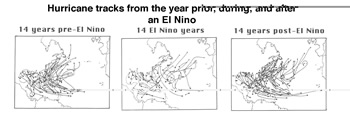For the latest forecasts and critical weather information, visit www.weather.gov/.
|
Back to Tropical Cyclones Climatology Page | Back to Main FAQ Page Subject: G2) How does El Niño-Southern Oscillation affect tropical cyclone activity around the globe? Contributed by Chris Landsea (NHC) The El Ni?o/Southern Oscillation (ENSO) resolves into a warm phase (El Ni?o), a cold phase (La Ni?a), and a neutral phase. During El Ni?o events (ENSO warm phase), tropospheric vertical shear is increased inhibiting tropical cyclone genesis and intensification, primarily by causing the 200 mb (12 km or 8 mi) westerly winds to be stronger (Gray 1984). La Ni?a events (ENSO cold phase) enhances activity. Recently, Tang and Neelin (2004) also identified that changes to the moist static stability can also contribute toward hurricane changes due to ENSO, with a drier, more stable environment present during El Ni?o events. 
The Australian/Southwest Pacific shows a pronounced shift back and forth of tropical cyclone activity with fewer tropical cyclones between 145° and 165°E and more from 165°E eastward across the South Pacific during El Niño (warm ENSO) events. There is also a smaller tendency to have the tropical cyclones originate a bit closer to the equator. The opposite would be true in La Niña (cold ENSO) events. See papers by Nicholls (1979), Revell and Goulter (1986), Dong (1988), and Nicholls (1992). The western portion of the Northeast Pacific basin (140°W to the dateline) has been suggested to experience more tropical cyclone genesis during the El Niño year and more tropical cyclones tracking into the sub-region in the year following an El Niño (Schroeder and Yu 1995) , but this has not been completely documented yet. The Northwest Pacific basin, similar to the Australian/Southwest Pacific basin, experiences a change in location of tropical cyclones without a total change in frequency. Pan (1981), Chan (1985), and Lander (1994) detailed that west of 160°E there were reduced numbers of tropical cyclone genesis with increased formations from 160E to the dateline during El Niño events. The opposite occurred during La Niña events. Again there is also the tendency for the tropical cyclones to also form closer to the equator during El Niño events than average. The eastern portion of the Northeast Pacific, the Southwest Indian, the Southeast Indian/Australian, and the North Indian basins have either shown little or a conflicting ENSO relationship and/or have not been looked at yet in sufficient detail. Reference Tang, B. H., and J. D. Neelin, 2004: "ENSO Influence on Atlantic hurricanes via tropospheric warming." Geophys. Res. Lett.: Vol 31, L24204.
|
TC FAQ
Links of Interest
AOML Tools & Resources
Employee Tools
|
